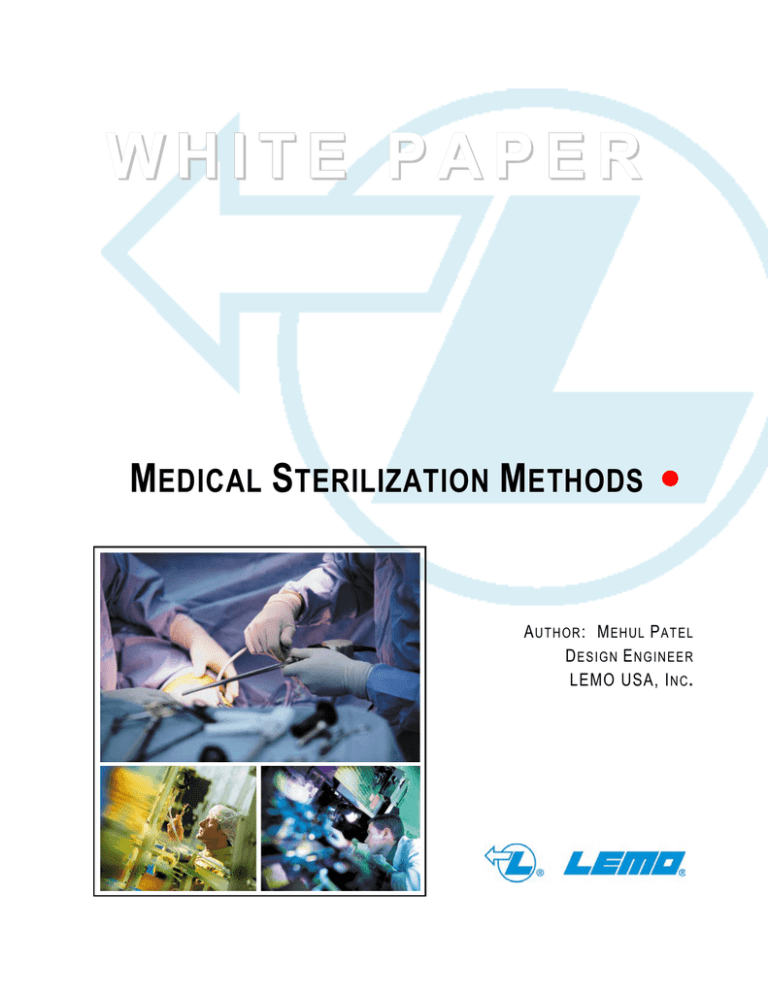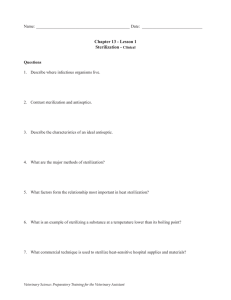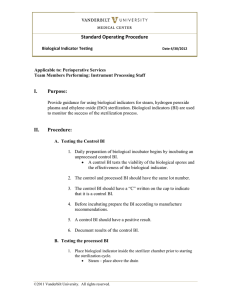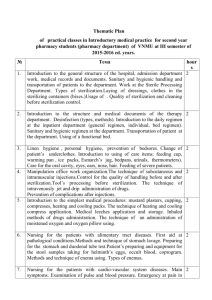
WHITE PAPER
M EDICAL S TERILIZATION M ETHODS
A UTHOR : M EHUL P ATEL
D ESIGN E NGINEER
LEMO USA, I NC .
Medical Sterilization Methods – White Paper
TABLE OF CONENTS
Introduction........................................................................................................................3
1.
What is Sterilization? .......................................................................................3
1.1 Definition ..................................................................................................3
1.2 Sterilization vs. Disinfection......................................................................3
Table 1: Sterilization Categories ..............................................................4
2.
Common Sterilization Methods .......................................................................5
2.1 Common High Temperature / Pressure Sterilization ................................5
A. Steam Autoclave ................................................................................4
2.2 Common Chemical Sterilization ...............................................................6
A. Ethylene Oxide (EtO) Gas ..................................................................6
B. Sterrad® – Low Temperature Hydrogen Peroxide Plasma .................7
C. Steris System 1® – Sterile Processing System...................................8
D. Cidex® OPA Solution – Alternative to Glutaraldehyde........................8
2.3 Common Radiation Sterilization ...............................................................9
3.
Other Sterilization Methods ...........................................................................10
3.1 Other High Temperature / Pressure Sterilization ...................................10
A. Dry Heat ...........................................................................................10
3.2 Other Chemical Sterilization...................................................................10
A. Glutaraldehyde (Cidex Plus® and Cidex®) ........................................10
B. VHP® (Vaporized Hydrogen Peroxide) MD Series .............................11
C. Chlorine Dioxide ...............................................................................11
D. Ozone ...............................................................................................11
3.3 Other Radiation Sterilization...................................................................12
A. E-Beam Radiation ............................................................................12
A. X-Ray Sterilization ............................................................................12
4.
Conclusion ......................................................................................................13
Table 2: Sterilization Comparison Table ................................................14
5.
References ......................................................................................................15
Page 2 of 16
Dec 2003
Medical Sterilization Methods – White Paper
INTRODUCTION
This paper describes the different sterilization methods and technologies currently
available in today’s medical equipment sterilization market. Each method is reviewed in
detail and major differences amongst each are highlighted.
Focus is given to the more common sterilization methods used and/or available for
medical equipment in hospitals and clinics today. At the end of the paper, there is a
conclusion and table, which summarizes the common sterilization methods. Six
sterilization methods/products were isolated and ranked based on their sterile efficacy
and applicability to medical instruments.
1. What is Sterilization?
1.1. Definition
According to the CDC (Centers for Disease Control and Prevention), “Sterilization
means the use of a physical or chemical procedure to destroy all microbial
life, including highly resistant bacterial endospores.”
Bacterial spores are the most resistant of all living organisms because their capability
to withstand destructive agents.
Although the chemical or physical process used to destroy all pathogenic microorganisms including spores is not absolute, when all parameters of the sterilization
process have been met, instruments, supplies and equipment are thought to be sterile.[1]
1.2. Sterilization vs. Disinfection
While discussing this topic, it becomes important to distinguish between sterilization
and disinfection. Sterilization results in destruction of all forms of microbial life,
while disinfection results in destruction of specific pathogenic microorganisms.[2]
Because disinfection is faster and less expensive, some hospitals substitute highlevel disinfection for sterilization of medical instruments.
An object should be disinfected or sterilized depending on its intended use. Critical
objects (those that enter sterile tissues or the vascular system or through which
blood flows, such as implanted medical devices) require sterilization before use.
Items that touch mucous membranes or nonintact skin, like endoscopes, respiratory
therapy equipment, and diaphragms, require high-level disinfection.
Sterilization falls into the following three categories:
• High temperature/pressure sterilization (autoclave)
• Chemical sterilization
• Radiation sterilization
Page 3 of 16
Dec 2003
Medical Sterilization Methods – White Paper
The following table summarizes the various sterilization methods available within each
category:
Table 1. Sterilization Categories
Sterilization Categories
Common Methods
Others
High
Temperature/Pressure
• Steam Autoclave
• Dry Autoclave
Chemical
• Ethylene Oxide (EtO)
• Glutaraldehyde (Cidex Plus,
Cidex)
• Sterrad
• Steris System 1
Radiation
• VHP MD Series
• Cidex OPA Solution
• Chlorine Dioxide
• Gamma
• Electron Beam (E-Beam)
• Ozone
• X-Ray
Page 4 of 16
Dec 2003
Medical Sterilization Methods – White Paper
2. Common Sterilization Methods
2.1. Common High Temperature/Pressure Sterilization
A. Steam Autoclave
Steam autoclave is the oldest, safest, and most cost effective method of sterilization
in the medical equipment industry. The steam reaches 121-148°C (250-300°F) in the
pressure chamber at 15 P.S.I. The sterilization period is dependent on the temperature and size of load and can range from 10-60 minutes.
The common types of steam sterilization cycles are gravity-displacement, which
removes air from the chamber by gravity displacement as steam-entering
chamber exerts pressure on air; and the pre-vacuum cycle, which removes air by
a vacuum pump while steam is simultaneously injected into the chamber. The
following summarizes the processing parameters for each cycle:
Configuration
Gravity-Displacement
Pre-vacuum
Temperature
121-123º C (250-254º F)
132-135º C (270-272º F)
132-135º C (270-272º F)
Time
15 - 30 minutes
10 - 25 minutes
3 - 4 minutes
Configurable cycles allow the user to customize the sterilization cycle for items such
as hard items, wrapped items, liquids in vented containers, waste, and glassware.
The fastest steam sterilization used is flash sterilization and it can be accomplished
using either gravity-displacement, or pre-vacuum cycles. It is generally a high-speed
steam sterilization of an unwrapped instrument or device for 3 to 10 minutes in
132°C saturated steam.[15] This type of sterilization is only intended for use in
hospital operating rooms for urgently needed equipment.
In the steam autoclave process, microorganisms are killed by heat, and this is
accelerated by the addition of moisture. Steam by itself is not sufficient for
sterilization, and pressure that is greater than atmospheric is needed to increase
the temperature of steam for thermal destruction of microbial life.
Steam, for a specified time at required temperature, must penetrate every fiber and
reach every surface of items to be sterilized. When steam enters the sterilization
chamber under pressure;
•
•
It condenses upon contact with cold items.
This condensation frees heat, simultaneously heating and wetting all
items in the load, thus providing heat and moisture.
Any living thing will be killed when exposed to saturated steam at 120°C (250° F)
longer than 15 minutes. As temperature is increased, time may be decreased. A
minimum temperature-time relationship must be maintained throughout all portions
of load to obtain effective sterilization. At the end of the cycle, re-evaporation of
water condensate must effectively dry contents of the load to maintain sterility.[3]
Page 5 of 16
Dec 2003
Medical Sterilization Methods – White Paper
Application:
Steam autoclave is used mostly for surgical instruments. This method is not well
suited for heat sensitive materials and instruments.
Many surgical instruments are not designed to withstand prolonged heat and
moisture of the steam sterilization process. This leads to alternative sterilization
categories: chemical sterilization and radiation sterilization, which allow heat and
moisture sensitive materials to be sterilized.
2.2. Common Chemical Sterilization
A. Ethylene Oxide (EtO) Gas
Ethylene Oxide gas was introduced in the 1950’s, and it is an effective, low
temperature chemical sterilization method. It also takes longer than steam
sterilization, typically, 16-18 hours for a complete cycle. Temperatures reached
during sterilization are usually in the 50-60°C range.
Ethylene oxide (EtO) is a chemical agent that kills microorganisms, including
spores. EtO gas must have direct contact with microorganisms on the items to
be sterilized. Due to EtO being highly flammable and explosive in air, it must be
used in an explosion-proof sterilizing chamber in a controlled environment.
Items sterilized by this process must be packaged with wraps and be aerated.
The aeration time may be long and is needed to make sterilized items safe for
handling and patient use.[4]
Note: There are also gas sterilizers available that use a mixture of EtO with
carbon dioxide or chlorofluorocarbon (CFC) to represent it as nonflammable for
use in healthcare facilities. In addition to safety concerns, this type of sterilization
process requires an even longer aeration process compared to pure EtO sterilization.
In general, EtO gas is a reliable and safe agent for sterilization when handled
properly. OSHA1 also has special handling guidelines for Ethylene Oxide.
Application:
EtO is used to sterilize items that are heat or moisture sensitive. Disadvantages
of EtO gas are that it can leave toxic residues on sterilized items and it
possesses several physical and health hazards to personnel and patients that
merit special attention.
Since EtO poses several health hazards, there are currently two alternative
technologies that are currently available: Sterrad, a plasma phase hydrogen
peroxide-based sterilizing agent and Steris, a per acetic acid based technology.[5]
1
OSHA- Occupational Safety and Health Administration
Page 6 of 16
Dec 2003
Medical Sterilization Methods – White Paper
B. Sterrad - Low Temperature Hydrogen Peroxide Plasma
(A Johnson & Johnson product)
Introduction to Low Temperature Plasma:
Low temperature plasma sterilization was introduced to fill the gap between
autoclave: high temperature steam sterilization (safest, fastest and least
expensive) and EtO gas sterilization, which leaves toxic residuals. It is a low
temperature, non-toxic, but fairly expensive sterilization method. In this process,
hydrogen peroxide is activated to create a reactive plasma or vapor.
Note: Plasma is ionized gas made up of ions and electrons and is distinguishable
from solid, liquid, or gas. Plasma is often referred to as the fourth state of matter.
The Sterrad system is a Hydrogen Peroxide Gas Plasma Sterilization system
with an operating temperature range of 45-50°C. Operating cycle times range
from 45-70 minutes, depending on size of system.
This sterilization system uses a combination of hydrogen peroxide and low
temperature gas plasma to quickly sterilize most medical instruments and
materials without leaving any toxic residues. Hydrogen peroxide is a known antimicrobial agent that is capable of inactivating resistant bacterial spores.[6]
Sterilization by this method occurs in a low moisture environment.
The Hydrogen Peroxide Plasma Process using Sterrad:
The process consists of two consecutive and equal sterilization phases.
Vacuum / Preplasma Stage:
• When a low pressure is achieved in the vacuum stage, low temperature air
plasma is generated. This helps in removing residual moisture from the chamber.
The system is then vented to atmospheric pressure at the end of this stage.
Sterilization Stage:
• Pressure in chamber is reduced and an aqueous solution of hydrogen
peroxide is injected and vaporized into chamber.
•
•
•
•
The hydrogen peroxide diffuses throughout the chamber, surrounds the items
to be sterilized, and starts the inactivation of the microorganisms.
After the pressure is reduced, applying radio frequency (RF) energy creates
an electric field and thus forms low temperature plasma.
Free radicals are generated in the plasma by breaking apart the hydrogen
peroxide vapor. Once the activated components react with the organisms
and kill them, they lose their high energy and re-combine to form oxygen,
water vapor, and nontoxic by-products.
This is half of the total sterilization process. The other half of the cycle is
completed by repeating the above sterilization steps.
Page 7 of 16
Dec 2003
Medical Sterilization Methods – White Paper
•
At the completion of the second half cycle, the source of RF energy is turned
off, vacuum is released, and chamber is returned back to atmospheric
pressure by introduction of filtered air.[6]
Application:
This system is best suited to sterilize heat sensitive medical equipment such as
endoscopic equipment. With two systems, Sterrad provides sterilization solutions for
both smaller and larger applications.
C. Steris System 1 Sterile Processing System
(A Steris Corporation product)
The Steris System 1 is another, more common, low temperature sterile processing
system. It uses the Steris 20 Sterilant Concentrate that combines peracetic acid, a
chemical biocidal agent, and a proprietary anti-corrosion formulation to kill microorganisms at low temperature.[7] The process is achieved at a temperature of
50-56°C.
The Steris 20 Sterilant Concentrate is mixed with sterile water to create the
solution that flows into the sterilization chamber. The sterilization time is 12 minutes.
This is followed by repetitive sterile water rinses to complete the process. The entire
process is completed in less than 30 minutes for a standard cycle.[9]
Peracetic acid, by itself, is an oxidant and disinfecting agent for liquid immersion.
It maintains its effectiveness when high levels of organic debris are present. It is
an acetic acid plus an extra oxygen atom that reacts with most cellular
components to destroy cells.[8]
Application:
Only immersible instruments can be used with this method, and only a few
instruments can be sterilized at one time. No packaging required.
D. Cidex OPA Solution – Alternative to Glutaraldehyde
(A Johnson & Johnson product)
Cidex® OPA Solution is a High Level Disinfectant (HLD) for use in reprocessing heat
sensitive medical devices. Cidex OPA Solution provides high-level disinfection in 12
minutes at room temperature (20oC) and is particularly active against mycobacteria,
including glutaraldehyde-resistant strains of M. chelonae.[10] CIDEX OPA Solution
has the broad materials compatibility of glutaraldehyde (but does not contain
glutaraldehyde), requires no activation, and has minimal odor. The Cidex OPA
Solution is replacing Cidex and Cidex Plus due to their toxicity concerns.
Application:
This solution is frequently used on surgical cameras (endoscopes). The item to
be disinfected must be thoroughly cleaned and dried before immersion. After
immersion, the item must be rinsed thoroughly with sterile water prior to use.
Page 8 of 16
Dec 2003
Medical Sterilization Methods – White Paper
2.3. Common Radiation Sterilization
A. Gamma, Beta Sterilization
Irradiation is an effective sterilization method, but it is limited to commercial use
only. The product to be sterilized is exposed to radiation for 10 to 20 hours,
depending on the strength of the source. The highest temperatures reached in
gamma sterilization are usually 30-40°C. Gamma radiation is popular for sterilizing before shipment and it can be done through the packaging. A dose of 2.5
megarad is generally selected for many items.
Ionizing radiation produces ions by knocking electrons out of atoms. These
electrons are knocked out violently, and strike an adjacent atom and either attach
themselves to it, or dislodge an electron from the second atom. The result is
ionic energy that becomes converted to thermal and chemical energy. This energy
kills microorganisms by disruption of the DNA molecule, therefore preventing
cellular division and propagation of biologic life.
The principal sources of ionizing radiation are beta particles and gamma rays.
Beta particles, free electrons, are transmitted through a high-voltage electron
beam from a linear accelerator. These high-energy free electrons will penetrate
into matter before being stopped by collisions with other atoms. This means their
usefulness in sterilizing an object is limited by the density, thickness of the object
and by the energy of the electrons. These free electrons produce their effect by
ionizing the atoms they hit, producing secondary electrons that kill microorganisms.
Cobalt 60 is a radioactive isotope capable of breaking down to produce gamma
rays. Gamma rays are electromagnetic waves that have the ability to penetrate
a much greater distance than beta rays before losing their energy from
collision. Because they travel with the speed of light, they must pass through a
thickness measuring several feet before making sufficient collisions to lose all of their
energy. Cobalt 60 is the most commonly used source for irradiation sterilization.[3]
Application:
The radiation can change the properties of some materials like plastics and have
adverse affects on glues or adhesives.
As you can see, each of the six common methods discussed above have their
advantages and disadvantages.
Page 9 of 16
Dec 2003
Medical Sterilization Methods – White Paper
3. Other Sterilization Methods
In this section, the other, less common sterilization methods are described. These methods
are either existing, being replaced by new sterilization, or are still in development.
3.1. Other High Temperature / Pressure Sterilization
A. Dry Heat
This process is conducted at 160-170°C for a minimum of two hours. Due to its
high temperatures, its applicable use is limited.
Dry heat in the form of hot air is used primarily to sterilize anhydrous oils,
petroleum products, and bulk powders that steam and ethylene oxide gas cannot
penetrate. In the absence of moisture, higher temperatures are required than
when moisture is present because microorganisms are destroyed through a very
slow process of heat absorption by conduction.[3]
3.2. Other Chemical Sterilization
A. Glutaraldehyde (Cidex Plus and Cidex)
(A Johnson & Johnson product)
Cidex Plus and Cidex are two of the brand names for Glutaraldehyde, which has
been a known disinfectantL in the medical industry. It has been found that these
two solutions can provide sterilization after 10 hours of use, but the manufacturer
has not verified this claim.
•
Cidex Plus Solution is a disinfectant that is used to disinfect medical instruments.
It is a 3.4% alkaline glutaraldehyde solution, which has tuberculocidal and highlevel disinfection capabilities. It achieves high-level disinfection in 20 minutes at
25°C and has up to a 28-day reuse life.[10]
•
Cidex Activated Dialdehyde Solution is used to disinfect medical instruments and
endoscopes. This solution can also be used in an automated reprocessor. (An
automated reprocessor is the machine used to disinfect endoscopic and medical
devices with a high level disinfectant solution.) It is a 2.4% alkaline
glutaraldehyde solution, which has tuberculocidal and high-level disinfection
capabilities. It achieves high-level disinfection in 45 minutes at 25°C and has
up to a 14-day reuse life.[10]
Both have been used as a cold liquid high-level disinfectant for heat sensitive equipment.
Note: Cidex (glutaraldehyde) products are being withdrawn from the European
market due to concerns that it is toxic and harmful to health care staff in
hospitals. Also, the U.S. market is requiring glutaraldehyde-free chemical
solutions, which led to the formulation of the Cidex OPA solution. Cidex OPA
solution is now known as the alternative to glutaraldehyde. See 2.2
Page 10 of 16
Dec 2003
Medical Sterilization Methods – White Paper
B. VHP MD Series
(A product of Steris Corporation)
VHP (Vaporized Hydrogen Peroxide) MD Series Sterilization System for Medical
Devices is yet another low temperature sterilization system. It is also a product of
Steris Corporation. It is different from the Sterrad system, in that it only uses
hydrogen peroxide in vaporized form for sterilization, while the Sterrad system uses
vaporized hydrogen peroxide to initiate the sterilization, and then plasma (created by
RF energy) to complete the sterilization process.
In the VHP process, hydrogen peroxide vapor is injected into the chamber via a
series of pulses to sterilize packaged medical and diagnostic devices. The cycle
time is 2 hours and the operating temperature ranges from 30-40°C.
Note: This system is large capital equipment that uses hydrogen peroxide as the
sterilant and it can sterilize multiple pieces of equipment at one time. On the other hand,
Steris Corporation’s other product, the Steris System 1 is a portable tabletop system that
uses peracetic acid as the sterilant and it is used to sterilize equipment right before use.
The VHP system is relatively new (out on market for a year) and has yet to be
commonly used in medical sterilization applications. Like the Sterrad system, it is
intended to fill the gap between steam sterilization and EtO gas sterilization.
C. Chlorine Dioxide
Chlorine Dioxide is a chemical liquid sterilization process. The best operating
temperature range for this process is 25-30°C, while using low concentrations of
ClO2. The process requires 6 hours of contact time to achieve sterilization. The
presence of organic matter reduces activity. A processor converts a compound of
dilute chlorine gas with sodium chlorite to form ClO2 gas and this gas is then
exposed to the equipment in a sterilizing chamber.
Note: This alternative may corrode some materials and must be generated onsite. Prehumidification of the ClO2 is also required.[13]
D. Ozone
Ozone sterilizes by oxidation, a process that destroys organic and inorganic matter. It
penetrates membrane of cells causing them to explode. In this process, a generator is
used to convert oxygen to ozone, as a 6 to 12 percent concentration of ozone
continuously flows through the chamber. Ozone penetration is controlled by vacuum
pressure or by adding humidity. After the process is complete, oxygen is allowed to flow
through the chamber to purge the ozone. The cycle time may be up to 60 minutes
depending on the size of the chamber or load of items to be sterilized.[3]
Ozone is formed by applying electrical energy to the oxygen molecule, which splits
some portion of those oxygen molecules in half, into singlets of O. Therefore ozone
molecules contain three atoms of oxygen and are unstable. Due to ozone gas being
Page 11 of 16
Dec 2003
Medical Sterilization Methods – White Paper
corrosive, and it being able to damage moisture sensitive equipment, there has not been
much use of it in the medical industry.
3.3. Other Radiation Sterilization
A. E-Beam Radiation
In this process, the E-beam generator delivers a high dose of electrons in a narrow
beam at the items to be sterilized. The electrons from the E-beam generator have
limited penetrating power, less than gamma radiation. For example, a 10MeV Ebeam will penetrate about 5 cm of a unit-density material.[11]
B. X-Ray Sterilization
This is a new developing process that is based on obtaining X-rays through
conversion of electron beams. The X-rays produced have the same penetrating
properties as the rays produced by Cobalt-60. But with this, treatment is faster,
more flexible, and more environmentally friendly.
X-rays offer excellent product penetration in sterilization, thoroughly treating the
surface and interior of a product.[12]
Page 12 of 16
Dec 2003
Medical Sterilization Methods – White Paper
4. Conclusion
There are many sterilization methods available on the market, and it is critical to
know that different sterilization methods tailor to different material types, therefore
different equipment. Many of the emerging sterilization methods are low temperature
based. It is known that steam autoclave is the most widely used, inexpensive, and
effective sterilization method that is currently available. Also, historically, many
hospitals have relied on EtO- based sterilization systems, but due to environmental
and safety concerns, they have been investigating alternatives. Thus, we also
discussed the two common, low temperature sterilization alternatives to EtO Gas
sterilization: Steris System 1 and Sterrad.
The primary difference between the two: Steris and Sterrad, is that Steris System 1 is
a “just in time” technology that requires sterilized items to be immediately used after
being removed from the unit.[5] This aspect of Steris makes it impractical in such cases
where the need for specific instruments cannot be known ahead of time. Also, Steris
Corporation’s VHP MD Series System was also discussed and it is a new low
temperature sterilization system that will directly compete with the Sterrad system.
The best, most established, low temperature sterilization method that fills the gap
between steam sterilization and EtO gas sterilization, is the hydrogen peroxide
plasma technology developed by Sterrad. Although Sterrad is an expensive
sterilization method, it is effective and versatile. Also, despite its longer cycle time,
the VHP MD Series System has its benefits and will become a more common
sterilization system in the future. Out of the six common methods investigated, here
are the current rankings of the methods from the most useful to the least useful for
medical equipment sterilization:
1.
2.
3.
4.
5.
6.
Steam Autoclave
Sterrad
Steris System 1
Ethylene Oxide Gas (EtO)
Cidex OPA Solution
Gamma Radiation
Page 13 of 16
Dec 2003
Medical Sterilization Methods – White Paper
The following table summarizes the results:
Table 2: Sterilization Comparison Table
High
Temperature/
Pressure
Steam
Autoclave
Chemical
Radiation
Sterrad
Steris
System 1
EtO Gas
Cidex OPA
Gamma
121-148
45-50
50-56
50-60
20
30-40
Cycle Time
(minutes)
10-60
55-70
30
16-18 hours
(Full day)
12
10-20 hours
Sterilant/
Disinfectant Type
Steam
-Hydrogen
peroxide vapor
-Gas plasma
-Peracetic acid
-Proprietary anticorrosion
formulation
EtO gas
Orthophthalaldehyde
Radiation
Energy
√
√
√
Temperature (°C)
Sterilization
√
√
Disinfection
Environmentally
Friendly?
Advantages
Disadvantages
√
Yes
No
Leaves toxic
residuals
Yes
Yes
-Safe
-Effective
-Economical
-Reliable
-Fast
-Safe
-Effective
-Low moisture
environment
-No toxic
residues
-No aeration
needed
-Heat sensitive
materials can be
sterilized
-Safe
-Non-toxic
-Short cycle time
-Effective
-Low
temperature
-Handles heat
or moisture
sensitive
equipment
-Reliable
-Quick
-Minimal odor
-Primary use with
surgical cameras.
-Broad materials
compatibility
-Simple
-Reliable
-Cost
competitive
-Fast
-Wets and heats
materials
-Corrosion is
possible
-Not suited for
heat sensitive
materials
-Damages Nylon
based materials
-Very expensive
-Handles only
small items
-Have to soak in
solution
-Marketed for
“point of use”
applications only
-Long cycles
-Toxic by
product
-Carcinogenic
-Costly
-Long aeration
-Physical, health
hazards
-Costly
-Disinfectant, not a
sterilant
-PVC, PTFE,
and Acetal
are
incompatible
materials
Page 14 of 16
Yes
Yes
Dec 2003
Medical Sterilization Methods – White Paper
5. References
[1] http://education.sterrad.com/c3/c3_types.htm
[2] http://www.steamatic-cr.com/bioclean/PRINCIPLES.html
[3] http://www.urmc.rochester.edu/sterile/basics.html
[4] http://education.sterrad.com/c3/c3_chemical_eto.htm
[5] http://www.ciwmb.ca.gov/wpie/HealthCare/EPAEtOGluto.pdf
[6] http://www.sterrad.com (Sterrad 100S Sterilization System, pg. 1-2)
[7] http://www.steris.com
[8] http://education.sterrad.com/c3/c3_chemical_peracetic.htm
[9] Malchesky, Paul S., Peracetic Acid and Its Application to Medical Instrument
Sterilization, 1992, pg. 149.
[10] http://www.cidex.com
[11] http://www.wheatlonsci.com/html/PlasticsSterilization.html
[12] http://www.iba-sni.com/pages/xray.htm
[13] http://p2library.nfesc.navy.mil/P2_Opportunity_Handbook/3_VII_1.html
[14] Robins, D. Stephen, Health Facilities Management, State-of-the-Art Sterilization,
May 96, Vol.9, Issue 5
[15] http://www.flashpak.com/frequent.html
Page 15 of 16
Dec 2003
635 Park Court, Rohnert Park, CA 94928
P.O. Box 2408, Rohnert Park, CA 94928-2408
(800) 444-5366 • (707) 578-8811 • fax (707) 578-0869
www.LemoUSA.com • email: info@lemousa.com
Notice: The information contained in this document is subject to change without notice. LEMO makes no warranty of any kind with regard to this material, including,
but not limited to, the implied warranties of merchantability and fitness for a particular purpose. LEMO shall not be liable for errors contained herein or for incidental or
consequential damages in connection with the furnishing, performance or use of this material.
Reproduction, adaptation or translation of this document is prohibited without prior written permission of LEMO.
All brand and product names are trademarks or registered trademarks of their respective companies.
2003 LEMO USA, inc. All rights reserved. LEMO is a registered trademark of INTERLEMO HOLDING SA







